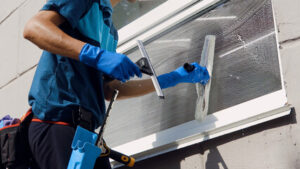The septic tank is an integral part of every on-site wastewater system. It removes solid wastes before the effluent proceeds to the soil absorption field and stores them until they can be digested or disposed of.
The heavy solids settle to the bottom of the septic tank, and the lighter solids, including fats and grease, float to the surface. Pumping regularly keeps these layers from accumulating to the point where they restrict new wastewater flow. Click the Septic Tank Services Near Me to learn more.

Septic tank pumping is necessary to prevent sludge and scum buildup, which can cause drain clogs, system failure and costly repairs. Regular tank pumping also extends the life of the septic system and protects water quality.
How often a septic tank needs to be pumped is based on several factors. The number of people living in the home will determine the size of septic tank required and how much wastewater is produced per day. A family of four will typically require a larger septic tank than a one-bedroom house.
A septic tank should be cleaned every three years to maintain its ability to separate solid waste from the wastewater. In addition to removing the solids, this process will also help identify any problems, such as cracks or leaks in the tank and the lid or baffles that restrain and redirect the flow of incoming and outgoing wastewater.
A septic tank that is not pumped regularly can fail to properly treat wastewater, leading to sewage backing up into the home and surrounding property. A professional can clean and pump a septic tank while checking for leaks and other issues. Many septic tank services also include a PSMA-certified inspector, which allows them to diagnose other septic system problems and recommend appropriate repair work. In addition to septic tank cleaning, homeowners can also save on maintenance costs by conserving water usage. This may mean adjusting washing machine loads to full or partial loads and using caustic drain openers sparingly.
Inspection
A septic inspection is an opportunity to check for issues with your tank and septic system as a whole. A professional septic inspector will take a look at the septic tank, distribution box and leach field. They will also flush toilets and run faucets to test the pressure in your septic tank and leach field. They will look for red flags such as a dingy distribution box or puddling anywhere in the leach field.
Septic tanks can crack over time, and these cracks will cause the septic tank to leak. A septic tank that is leaking will turn the surrounding ground into a cesspool. Regular septic system inspections will catch these issues before they become major problems and save you money.
In addition to having septic system inspections done on an annual basis, it’s important to keep clear and concise maintenance records. This will allow any prospective buyers to see that you’ve taken good care of your septic system, making the property more appealing to them.
Repair
The septic system at a home or business manages waste that is not processed by the municipal sewer systems. A septic tank and drain field are an effective alternative to centralized sewage treatment but they require routine care. A septic system that is not pumped and cleaned can back up into the house, cause health problems and be an environmental hazard. Regularly pumping the septic tank removes solids that accumulate, prevent wastewater flow and clog drain pipes.
Bacteria in the septic tank break down solid waste such as toilet paper, food scraps and hair to produce sludge that sinks and fats and grease, called scum, that floats to the surface. Clear wastewater drains into dispersal fields or sewage treatment plants.
A septic tank that is not pumped can cause clogs and backups, contaminate groundwater and emit foul odors into the home. It is important to schedule cleaning and maintenance services for septic tanks on time.
An effective septic tank service company utilizes septic service software to streamline the customer management process. This software allows businesses to create customer profiles with granular job and service agreements for recurring maintenance. It also allows septic tank service companies to use a digital calendar that shows workload and prioritizes appointments. This ensures that the best technicians are working on the most urgent and high-priority jobs.
Installation
Your septic tank is where wastewater undergoes a process of settling and separation. Heavier solid waste particles sink to the bottom, forming a layer known as sludge. Lighter, odor-less materials rise to the top, creating a layer called scum. In between these layers lies a middle layer that contains clearer, safer wastewater.
Once your septic system is installed, the tank must be inspected for cracks or leaks. A tank that is leaking should be resealed.
A septic system has an absorption field that slowly seeps safer, cleaner wastewater into the soil. This water helps nourish the ground and plants without chemical fertilizers or toxic nutrient treatments. The septic system also has a vent that allows gases that build up in the plumbing to escape.
Whenever you need a new septic system installed, you should only hire licensed professionals to design and install it. These individuals have passed written, oral, and practical examinations that test their knowledge of the State Sanitary Code. They will be able to recommend the right septic system gallon size and other factors that are specific to your home. It’s also important to have a professional map out the location of your septic tank and system components so you don’t accidentally damage or disturb any parts while performing home maintenance or landscaping. You should also avoid driving or parking any equipment over a septic tank or absorption field.
Save Time
Septic tank pumping is a process that involves cleaning and emptying your home’s waste. It’s not an easy job to do on your own. For one, it requires a lot of time and effort to acquire all the right tools. Besides, you have to find a place where you can dump the waste and transport it there. You also need to know how to identify the source of the problem so that you can fix it immediately.
The good thing is that there are companies out there that can help you save time by completing this task for you. They will come with a truck that has a large tank. They will then attach a suction hose to the septic tank and start sucking up the sewage. They will then put it into their truck and transport it to a sewage treatment site for proper disposal.
Having your septic tank pumped regularly helps you avoid a lot of stress and inconvenience. It also helps you save money. You can do some things to minimize the amount of sewage that gets into your tank, including using less water and not flushing non-human waste down the drains. Some examples include disposing of solvents, paint, varnish, oil, and pesticides in a safe way, not washing grease down the drain, and not flushing paper towels, tissues, kitty litter, or cigarette butts down the toilet.
If you don’t take care of your septic system, it can overwork itself and eventually break down. It’s important to take the time to schedule regular septic tank pump outs so that you can prevent these problems from occurring in the future.
A septic tank can last decades with proper maintenance. However, it’s an often forgotten aspect of homeownership because septic tanks are buried and their access ports are covered by dirt. This is why it’s so important to get your septic tank pumped regularly by professionals. It’s a simple but effective way to reduce unnecessary expenses and improve the quality of your life at home.





